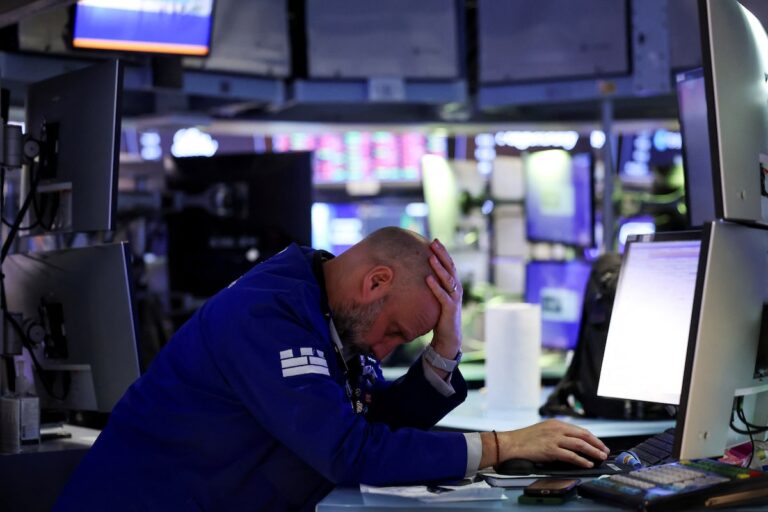Traders gestured as they worked on the floor of the New York Stock Exchange (NYSE) in New York City after the White House announced a 90-day suspension and lowered the US 10% mutual tariff on April 9, 2025.Brendan McDermid/Reuters
The pain was 10 out of 10, according to Takeuchi Shuntaro.
Not in a portfolio of Japanese stocks, he’s running out of San Francisco, California, but in his appendix.
It has to come out as a colleague at Matthews Asia called and charted the pass through the market defeat of a $7 billion asset manager.
“I was on a conference call two minutes before the surgery,” Takeuchi said. “The nurse said: “Do you really have to attend this?”
In Tokyo, Nikko was heading towards a 4% drop on Wednesday, with trillions being wiped out of global stocks. This is the biggest drop in dollar value for any market drawdown on record.
The 10-day trading since US President Donald Trump hit carmakers with tariffs has been the most convulsing since the 2020 pandemic panic as bonds, oil, gold and even the US dollar itself have been shaking violently.
The sale at the US Treasury, a safe asset for the Lynchpin in the global market, has been the heaviest for decades, as if to highlight how the trade and financial foundations are shaking.
The meltdown began in what Trump called “liberation day.”
He raised the highest tariff barrier around the US economy on April 2nd in 100 years.
In the following weeks, it turned into an open economic conflict with China. By Friday, tariffs had risen to 145%, which led to the US trade embargo.
Since April 2nd, market value of over $5 trillion has disappeared from the MSCI National Inventory Index of Global Stocks while riding a roller coaster. It revealed that investors are not ready for Trump’s tariff attacks, and that his unpredictability and reversal risks damaging the US location in the uneven core of finance.
“We’ve built up confidence, but we don’t know what the second-order impact will be from the market,” said Geoff Wilson, veteran fund manager in Australia.
“There could be some hedge funds that have fallen. There may be other consequences that will only be revealed in the coming weeks.” His funds were a disruptive buyer.
Grave cleaning
Initially, the epicenter of sales was all sorts of exposure to economic growth, including banks, industrial metals, and companies such as Apple with fixed supply chains in China.
Then on April 4, the tomb sweeping day, just before sunset in Beijing – national holidays to pay homage to its ancestors, China retaliated and placed a 34% tariff on imports from the US
Oil plunged to its first low in four years, with the main global stock market index tilting above the threshold of what market types call “correction” – a drawdown of over 10% from the peak.
Even gold, considered a shelter in times of chaos, began a fall, an ominous sign, as investors faced with margin calls were forced to sell their safest assets to square losses.
For Wong Kok Hoi, founder and CEO of APS Asset Management in Singapore, it was a scenario he had been worried about for many years.
“Obviously, in my dream, I didn’t think the tariff rate could reach 125%,” he said.
“Essentially, trade ceases between the two biggest economies in the world.”
Conveniently, for him, he is located in China’s semiconductor, artificial intelligence and biotech sector, and his portfolio has so far risen 20%.
Trade wars
On Wall Street, bankers dialed in to a global conference, trying to reassure rattling clients.
Last weekend there was hope that Trump would relent before tariffs were actually hit.
But returning from a weekend golf reporter, I asked him about the Air Force 1 market on Sunday, and he replied, “Sometimes you have to take medication.”
That opened the floodgate. The Nasdaq 100 futures quickly fell by more than 5%, and Nikkei futures hit a circuit breaker after diving 8% and continued to fall.
The CBOE volatility index, called the “Fear Gauge,” on Wall Street, was spiked above the 60 that is normally seen during meltdowns such as the 2020 and 2008 financial crisis.
The S&P 500 finished 17% below the record high that hit just seven weeks ago. Christopher Forbes, Asia Head of CMC Markets, said Friday and Monday were the highest volume trading days on record.
California’s Takeuchi was trying to make sure his portfolio was as protected as possible, except for the rush to surgery.
“We traded,” he said. He bought and sold when his books and watchlist stocks met their targets or bought prices, finding companies with limited exposure in the US, but he didn’t want to make a big bet on the sector or the outcome of the Trump trade war.
“I don’t want to be too dramatic about it. What we’re doing is not panic, control risks and focus on inventory selection.”
Bond Fire
For months, the currency market as a tool for global trade was expected to be the forefront of tariff price adjustments.
Instead, Shock came from bonds. Shortly after tariffs came into effect in the middle of a New York night, there was a huge wave selling the Treasury Department in Asia on Wednesday.
Usually, the market is liquid and deep and makes small movements, but this has risen wildly and unleashes the most man stage of the market’s tariff tantrum.
The 10th Treasury yield jumped near 20 basis points as a signal that traders were forced to sell somewhere in the market, or, more worryingly, a signal that US bonds are swinging as safe shelters.
However, within hours the market was whipped again. Trump has shocked the world by announcing a heavier bilateral tariff suspension, maintaining a 10% tax on imports and raising taxes again in China.
The stock rove higher and won some of its largest percentage gains since 2008, but there was so much uncertainty that it started wobbling again.
Whipping
Martin Wetton, Westpac’s head of financial market strategy and a 30-year market veteran in Sydney and London, said Wednesday’s bond trading had no historic precedent.
“The money didn’t scramble to secure US dollar funds and buy US dollars for safety. It’s an amazing and a sharp warning,” he said.
By Friday, the 11th session since Trump’s auto rates were announced, leaving me feeling like the dust settled. Beijing on Friday raised tariffs on US imports to 125%.
Inventories fell, and the 10-year dollar sinks in the safe haven Swiss franc, and talk changed to whether this period marks the beginning of the US domination of global finance.
“It’s like we had a year’s deal in just a few days,” said Jack McIntyre, portfolio manager for BrandyWine Global in the US.
“You’re focusing on what you know,” he said. He said in terms of slowing down the US economy and perhaps falling further into the dollar as the rest of the world continues to sell US assets.
Be smart with your money. Get the latest Investing Insights to your inbox with Globe Investor Newsletter three times a week. Sign up today.




